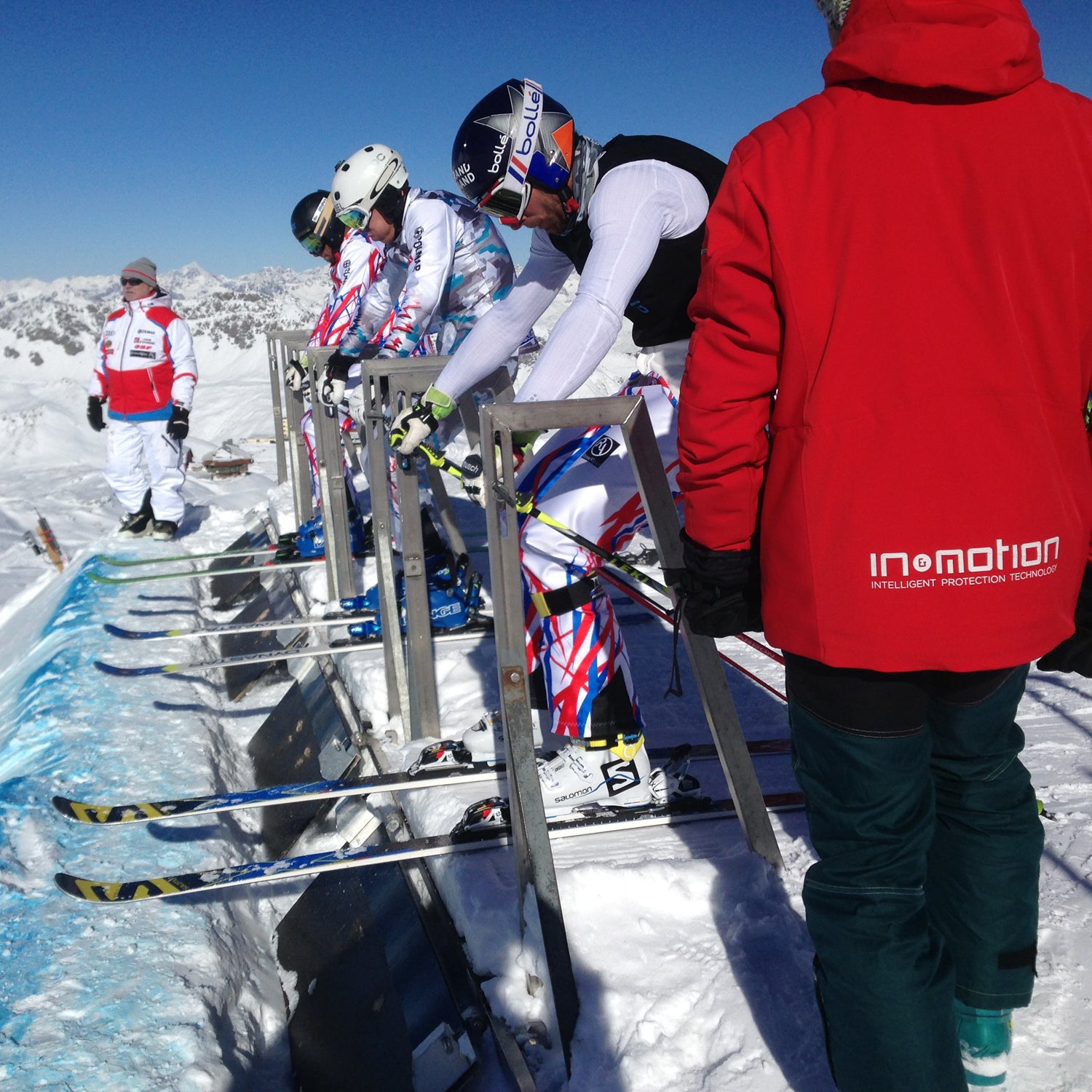Last February, at the SIA trade show, I watched a guy on a trampoline practice somersaults with trick skis and a prototype inflatable vest made by POC and French company . As soon as the jumper tilted beyond what would be an irrecoverable position for a skier (past about 30 degrees in any direction), an air bag detonated, transforming him into the Michelin Man well before he landed on the trampoline.
The point of the device, called the , is to protect professional alpine and ski-cross racers from potentially fatal crashes by enveloping them in a cushion before they hit the snow. (POC says it will sell the vests to amateur skiers by fall 2016 and it's also considering use of the air bag technology in downhill bike gear.) The system takes 1,000 measurements per second, so it can calculate the exact instant when a crash begins, while the air bag—designed to protect the neck, chest, and spine—inflates in fewer than 100 milliseconds. According to POC, it’s four times as effective at protecting a wearer’s spine than the company’s normal back armor. “It’s simple physics and [demonstrates] what we’ve learned in helmets,” says Oscar Huss, head of product development at POC in Sweden. “If you can slow the travel before the impact force reaches the body, that deceleration equals greater protection.”
The entire system—including accelerometers, gyros, GPS, and the air canister required to fill the vest—fit within the body of the company’s preexisting spine protector, says Huss. All told, it’s about the same size as two iPhones stacked on top of each other.
This isn’t the first air bag available to pro skiers. For nearly a decade, FIS, skiing’s international governing body, has worked with Dainese, the Italian maker of motorcycle and downhill mountain bike armor, on the D-Air inflatable vest, which was certified for use in pro alpine events in 2014. The D-Air is the evolution of an air bag vest that Dainese sells to motorcyclists: the D-Air Street, which went through more than 5,000 hours of tests, including 34 staged crashes. According to EU certification studies, the D-Air Street reduced crash impact forces by 72 percent compared with noninflating spinal protectors.
“Athletes are educated to go for the success,” Günter Hujara says. “If they have doubts, they don’t use equipment which could have some negative influence on their performance.”
Sasha Rearick, head coach of the U.S. men’s ski team, says he believes the Dainese D-Air has the potential to make ski racing much safer. “They’ve created an algorithm that tells the air bag when to go off. That algorithm could now be adapted to other aspects of safety since it can detect when an accident’s about to happen.” Rearick envisions bindings, knee braces, and other smart systems that would open, close, and otherwise act preemptively to prevent injury.
There’s just one problem: Neither the FIS nor the U.S. Ski Team has mandated use of the vests for its athletes. And without that mandate, it’s uncertain how many ski racers will voluntarily use them. In a widely quoted piece, Ted Ligety . So far, POC says four federations have adopted its vests for ski cross, but no A-list alpine racers are using it in competition. Dainese that a handful of U.S., Canadian, Austrian, and Italian racers, including the U.S. Ski Team’s Marco Sullivan, will compete with its vest for the 2015–16 World Cup Series, but none of the sport’s top athletes are mentioned.
“It’s too early to make that call [to mandate the vests],” Rearick says. While he believes in its potential, he says the technology hasn’t yet proven its efficacy. Nobody on the U.S. Ski Team has used one in competition, and only one team member, Sullivan, has worked with Dainese on testing.
Günter Hujara, an FIS technical expert, says the Austrian ski team mandated use of the D-Air in practice, but it’s the only team yet to do so. “Athletes are educated to go for the success,” Hujara wrote in an e-mail to ���ϳԹ���. “If they have doubts, they don’t use equipment which could have some negative influence on their performance.”
But here’s the thing: There’s no evidence that the vests will hurt performance. The athletes who remain wary of the tech say they fear the vests will increase drag. But the FIS mandated that the vests be aerodynamically neutral—neither aiding nor slowing down racers.
And there’s plenty of evidence that the vests would prevent serious injuries. Between 2006 and 2015, back and neck injuries were the second most common issue for pro skiers (behind only knee damage). Both internal and third-party studies from POC and Dainese prove that the air bag tech could reduce the severity of these injuries.
Skiing has a history of slow and imperfect enforcement of safety gear. Consider that the first helmets for downhill were mandated for the 1960 Olympics at Squaw Valley, but there was no uniform standard, and it took until the 1980s for helmet construction and quality to become standard across all national ski teams and for helmet use to spread across all disciplines.
Thirty years ago, helmets were the cutting edge of safety gear. Now, it's air bags. Let's hope it doesn't take ski racing's top governing body 20 more years to realize the vests' potential.


